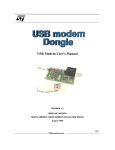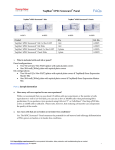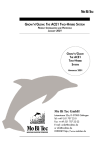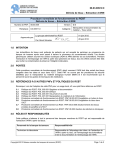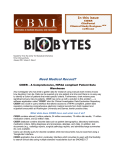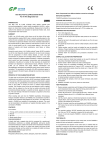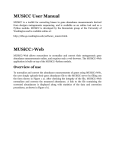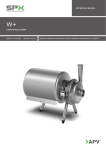Download AquaStool
Transcript
TM AquaStool © MoBiTec GmbH 2010 Page 2 Contents - General Information ........................................................................... 3 • Specification .................................................................................3 • Enabling Technology....................................................................3 • Multifunctionalities ........................................................................3 • Extract both Fecal DNA and RNA ................................................3 • Extract DNA and RNA of the Host and Microbes in Feces ..........4 • Not only for Fecal Specimens ......................................................4 • Comparison ..................................................................................4 - Protocols .............................................................................................5 • Stool Collection and Preservation ................................................5 • Stool Specimen Storage ..............................................................5 • Fecal DNA Extraction ...................................................................6 • Fecal RNA Extraction ...................................................................6 • PCR and RT-PCR Amplification ...................................................7 • Mouse Fecal DNA/RNA Extraction for Genotyping and RNAtyping .....................................................................................................9 • DNA/RNA Extraction from RNAlater Preserved Fecal Specimen ................................................................................................... 11 - Order Information, Shipping and Storage ...................................... 12 - Contact and Support ........................................................................ 12 MoBiTec GmbH, Germany Phone: +49 551 70722 0 Fax: +49 551 70722 22 E-Mail: [email protected] www.mobitec.com © MoBiTec GmbH 2010 Page 3 General Information Application: DNA/RNA extraction from fecal & other specimens. For in vitro research use only. Size: The kit is sufficient for the preparation of: 7001MT: 1 ml for 2 extractions 7030MT: 30 ml for 60 extractions Kit Contents: The AquaStool Kit includes the following items: 7001MT: 1 ml AquaStool Solution, Instruction Manual 7030MT: 30 ml AquaStool Solution, Instruction Manual Specification AquaStoolTM is a multifunctional aqueous solution for DNA and RNA isolation and purification from fecal biospecimens. This single solution functions to stabilize, preserve, extract fecal DNA/RNA, and remove contaminating PCR and RT-PCR inhibitors abundant in these biospecimens. It streamlines stool collection, stabilization, preservation, DNA/RNA extraction, and molecular analysis. Approximately 150 - 200 µg total nucleic acids can be isolated from 50 mg of human feces. Enabling Technology Stool is a readily accessible, abundant, under-utilized, and noninvasive source of biospecimen. It contains trillions of microorganisms living in our aerodigestive and gastrointestinal tracks, millions of human cells sloughed from these organs every day, and numerous macrophages and lymphocytes migrating between our gut lumen and blood circulation. It can be an unmatched and excellent barometer of our health and diseases, in particular, gastrointestinal cancers, infections, inflammations, and microbiome. However, stool is one of the most difficult and challenging biospecimens to obtain high-quality DNA and RNA from for molecular analysis due to its content of large amount of digestive enzymes that destroy the DNA and RNA prior to and during extraction, and numerous DNA and RNA contaminants that interfere with subsequent molecular analysis. AquaStool technology will facilitate the growth of stool-based sciences and accelerate the drive toward personalized medicine. Multifunctionalities AquaStool combines the functions of biospecimen stabilization, preservation, DNA/RNA extraction, and PCR inhibitor removal in a single solution. It streamlines biospecimen preservation, DNA/RNA extraction, and molecular analysis. It makes fecal DNA/RNA extraction simple, fast, economic, and convenient. MoBiTec GmbH, Germany Phone: +49 551 70722 0 Fax: +49 551 70722 22 E-Mail: [email protected] www.mobitec.com © MoBiTec GmbH 2010 Page 4 Extract both Fecal DNA and RNA AquaStool extracts both fecal DNA and RNA from the same fecal specimen, enabling noninvasive genotyping and RNAtyping for the identification of transgenic animals; monitoring wildlife animals; diagnosis of gastrointestinal disorders, and the study of RNA expression and its relationship to genetic variation. Extract DNA and RNA of the Host and Microbes in Feces AquaStool extracts total nucleic acids in feces, including DNA and RNA from the host, commensal bacteria, any invasive viruses, fungi, or parasites, and incompletely digested food, enabling forensic identifications; the study of human and animal microbiome; and diagnosis of bacterial, viral, fungal, and parasitic infections. Not only for Fecal Specimens The challenges we face in DNA and RNA extraction from fecal specimens exceed the challenges we encounter in most other biospecimens. Therefore, AquaStool protocols can be readily modified and adapted to DNA and RNA preservation and extraction from other biomaterials, such as microbes, culture cells, animal and plant tissues, and even insects, making AquaStool a universal reagent for the study and correlation of genetic mutation and gene expression of any life form. Comparison Comparison of Techniques for Biospecimen Stabilization Formalin R*later AquaStool Cross-linking High Salt Dehydration Enzyme Inactivation Irreversible Reversible Irreversible N/A Incompatible Compatible Damage to Specimen Yes No No Inactivation of Pathogens Yes No Yes PCR Inhibitor Removal No No Yes Stabilization and Extraction No No Yes Mechanism of Stabilization Enzymatic Activity Ethanol Precipitation MoBiTec GmbH, Germany Phone: +49 551 70722 0 Fax: +49 551 70722 22 E-Mail: [email protected] www.mobitec.com © MoBiTec GmbH 2010 Page 5 Protocols Streamlined Fecal Specimen Preservation, Preparation, and Analysis Protocols These protocols describe the use of AquaStool to collect, stabilize, preserve, ship, and store fecal specimens, extract fecal DNA and RNA, and analyze the purified fecal DNA and RNA by PCR and RT-PCR. Stool Collection and Preservation AquaStool stabilizes and preserves DNA and RNA by inactivating degradative enzymes. Unlike cross-linking reagents (e.g. formalin) AquaStool preserves the specimen without ® damaging the DNA and RNA, and unlike high salt preservatives (e.g. Ambion’s RNAlater ) it irreversibly inactivates DNases and RNases and pathogens. This protocol describes the use of 10 ml of AquaStool solution to collect one gram of human feces. However, using 0.5 ml of AquaStool solution to collect 50 mg of feces is sufficient for most applications. In addition to preserving fecal specimens, AquaStool may also be used to preserve other biospecimens, such as microbes, culture cells, animal and plant tissues, and even insects, for DNA, RNA, and protein extractions. Because of AquaStool’s ability to lyse and inactivate bacteria, viruses, fungi, and parasites, it reduces the biohazards of biospecimens and improves biosafety to research workers. 1. Transfer a level spoonful (~1 gram) of fresh stool into a 15 ml stool collection tube (SARSTEDT # 80.734.311) containing 10 ml of AquaStool solution, using the spoon attached to the cap of the stool collection tube. 2. Stir and smash the stool with the spoon to facilitate the contact of the specimen with AquaStool solution. Securely screw-tight the cap and shake the content vigorously a few times. 3. Bring or mail the stool specimen to the laboratory. Note: AquaStool preserved sample is stable at room temperatures and should have no problem with shipping in mild ambient temperatures. However, we have not studied if it is stable at extremely high temperatures, such as in an unventilated shipping container on a hot summer day. Therefore, shipment in blue ice gel packs should be considered to ensure all specimens from different climate regions will be exposed to the same shipping temperatures. Stool Specimen Storage Upon receiving the stool specimens in the laboratory, the samples can be stored at 4 °C for a week before processing or in a -20 or -70 °C freezer. However, for the convenience and streamlining of subsequent fecal DNA and RNA extractions, the sample is preferably divided into 0.5 ml aliquots, each containing ~50 mg of fecal materials, in 1.5 ml microfuge tubes as described below. 1. Vortex the stool specimen in the stool collection tube vigorously at top speed to fully homogenize the specimen. MoBiTec GmbH, Germany Phone: +49 551 70722 0 Fax: +49 551 70722 22 E-Mail: [email protected] www.mobitec.com © MoBiTec GmbH 2010 Page 6 2. Load ~100 µg of sand is (Sigma # 274739, white, 50 + 70 mesh) into 1.5 ml microfuge tubes. The sand required for bacterial cell lysis and DNA/RNA extraction. It is convenient to use the cap of a 0.2 ml PCR tube to scoop and add the sand into the 1.5 ml tubes. One capful of sands is ~90 - 100 µg. 3. Transfer 0.5 ml of the homogenized stool specimen into the 1.5 ml microfuge tubes preloaded with sands. Use a 1 ml blue pipet tip with its very tip been cut off for specimen transferring so it would not be clogged by fecal debris. 4. Label the tubes and store the samples at -20 or -70 °C for long-term storage. Fecal DNA Extraction 1. Extract the DNA: Retrieve 0.5 ml stool specimen in a 1.5 ml microfuge tube pre-loaded with 100 µg of sand from storage. Vortex the tube upside down at top speed for at least 60 s (i.e. beadbeating). Incubate at 65 °C for 15 min (may incubate at 22 °C with slightly lower DNA yield). Vortex again for 60 s after the incubation and centrifuge at 14000 x g for 5 min to pellet the debris. 2. Precipitate the DNA: Transfer 0.4 ml of cleared lysate to a 1.5 ml tube pre-loaded with 0.4 ml of isopropanol. Vortex for 10 s to mix. Centrifuge at 14000 x g for 5 min to pellet the DNA. Decant to discard the supernatant. Rinse the pellet by filling-up the tube with 70% ethanol using a squirt bottle (be sure to rinse the entire interior of the tube, including the cap and the mouth of the tube), and decant to discard the ethanol solution. Repeat the ethanol rinse 3 - 4 times. Tap the tube on a clean paper towel to remove residual ethanol and air-dry the pellet for 1 - 2 min. 3. Solubilize the DNA: Add 0.4 ml nuclease-free water to the pellet, pipet to dislodge the pellet, and then vortex at top speed to fully disperse the pellet. Incubate on ice for 10 min to release the DNA. Centrifuge at 14000 x g for 5 min to pellet the insoluble. Transfer the DNA supernatant to a new 1.5 ml microfuge tube (the DNA solution may appear light yellowish, but it no longer contains PCR inhibitors). The concentration of the DNA solution may be estimated by diluting 2 µl of the sample with 98 µl of TE buffer (pH 8) for OD260 and OD280 reading and then calculating the concentration using the formula of DNA concentration (ng/µl) = 50 (dilution factor) x 50 (ng/µl) x OD260. The expected DNA concentration should be around 200 ng/µl and the total DNA yield from 0.5 ml of AquaStool preserved stool specimen (~50 mg of feces) should be about 80 100 µg, which is 5 - 10 times higher than the DNA yield obtained with other fecal DNA extraction kits. Store the DNA solution at 4 °C or -20 °C. Fecal RNA Extraction 1. Extract the RNA: Retrieve 0.5 ml stool specimen in a 1.5 ml microfuge tube pre-loaded with 100 µg of sand from storage. Vortex the tube upside down at top speed for at least 60 s (i.e. beadbeating). Place the tube on a foam floater and immerse the tube in the water bath of a bath sonicator (Branson Ultrasonic Cleaner 2510, 40 kHz, Danbury, CT). (Note: It is critical to position the tube right on top of the head of the ultrasonic generator, as the ultrasonic strength decreases from the head of generator. Consult your user manual to identify the location of the generator head or do a test extraction to identify the position that produces the best RNA yield. For Branson 2510, the two generator heads are positioned just outside of the left and right sides of the MoBiTec GmbH, Germany Phone: +49 551 70722 0 Fax: +49 551 70722 22 E-Mail: [email protected] www.mobitec.com © MoBiTec GmbH 2010 Page 7 OPERATING LEVEL mark in the middle of the tank). Sonicate for 30 min at 22 °C (Note: You may place the sonicator in a ventilation hood with its door closed to reduce the noise during operation). Vortex again for 60 s after the sonication and centrifuge at 14000 x g for 5 min to pellet the debris. 2. Precipitate the RNA: Transfer 0.4 ml of cleared lysate to a 1.5 ml tube pre-loaded with 0.4 ml of isopropanol. Vortex for 10 s to mix. Centrifuge at 14000 x g for 5 min to pellet the RNA (DNA is sheared by sonication in the presence of sands, Fig. 1). Decant to discard the supernatant. Rinse the pellet by filling-up the tube with 70% ethanol using a squirt bottle (be sure to rinse the entire interior of the tube, including the cap and the mouth of the tube), and decant to discard the ethanol solution. Repeat the ethanol rinse 3-4 times. Tap the tube on a clean paper towel to remove residual ethanol and air-dry the pellet for 1 - 2 min. 3. Solubilize the RNA: Add 0.4 ml nuclease-free water to the pellet, pipet to dislodge the pellet, and then vortex at top speed to fully disperse the pellet. Incubate on ice for 10 min to release the RNA. Centrifuge at 14000 x g or 5 min to pellet the insoluble. Transfer the RNA supernatant to a new 1.5 ml microfuge tube (the RNA solution may appear light yellowish, but it no longer contains RT-PCR inhibitors). The concentration of the RNA/DNA solution may be estimated by diluting 2 µl of the sample with 98 µl of TE buffer (pH 8) for OD260 and OD280 reading and then calculating the concentration using the formula of RNA/DNA concentration (ng/µl) = 50 (dilution factor) x 45 (ng/µl) x OD260. The expected RNA/DNA concentration should be around 450 ng/µl and the total RNA/DNA yield from 0.5 ml of AquaStool preserved stool specimen (~50 mg of feces) should be about 150 - 200 µg, of which about 1/2 – 1/3 is RNA. Store the RNA solution at -20 °C or -70 °C. PCR and RT-PCR Amplification The most common application of fecal DNA and RNA is to determine if specific DNA or RNA sequences exist in the fecal specimen by PCR genotyping or RT-PCR RNAtyping for the diagnosis of cancers, bacterial, viral, fugal, and parasitic infections; identification of transgenic animals; analysis of human and animal intestinal microbiome; and survey of wildlife animals. However, most fecal DNA and RNA extraction methods are unreliable and often have a PCR failure rate ranging from 20 - 100%, due to their poor and inefficient DNA/RNA protection, extraction, and PCR inhibitor removal. AquaStool purified fecal DNA and RNA are suitable for various downstream applications. The PCR and RT-PCR protocols provided here may be adjusted for your specific application. 1. DNase I digestion. AquaStool extracted fecal RNA contains large amount of sheared DNA. RT-PCR can be performed without removing the contaminating DNA, if appropriate primer pair is designed to avoid the amplification of genomic DNA sequence or produce different amplicon size. Otherwise, DNaseI treatment is required prior to reverse transcription. To digest the DNA, 40 µl of the 400 µl of AquaStool purified RNA is incubated with 0.5 µl of DNaseI in its 1 x buffer at 22 °C for 40 - 60 min (Note: Almost all commercial DNaseI products have RNase activity. Using minimal amount of DNaseI and incubating at room temperature for extended period helps reduce RNA loss. Even if the DNA digestion is incomplete and there are still a lot of < 250 bp fragments, they would not likely affect your PCR or RT-PCR). Following DNase digestion, the DNase is removed with 4 µl of DNase Inactivation Reagent (Ambion # AM1906). MoBiTec GmbH, Germany Phone: +49 551 70722 0 Fax: +49 551 70722 22 E-Mail: [email protected] www.mobitec.com © MoBiTec GmbH 2010 Page 8 Figure 1. AquaStool purified fecal DNA and RNA. Aliquots (5 µl) of the extracted DNA (Lane 2), RNA (Lane 3), and DNaseI treated RNA (Lane 4) were run in a 0.8% agarose gel. As shown, AquaStool extracts intact fecal DNA and RNA. It recovers not only large RNAs but also small RNAs, including 5S rRNA, tRNA, and microRNA. 2. Reverse transcription. Anneal RT primer to its complimentary RNA by incubating 2 µl of 5 µM RT primer with 4 µl of DNaseI treated RNA and 12 µl of nuclease-free water at 80 °C for 4 min and then on ice. Following primer annealing, add 2 µl of 10 x buffer (you may use PCR reaction buffer), 0.2 µl of 25 mM dNTPs, and 0.5 µl of 100 U/µl MMLV Reverse Transcriptase to the mix and incubate at 42 °C for 60 min to synthesize the cDNA. Heat-inactivate the MMLV Reverse Transcriptase by incubating at 94 °C for 10 min. 3. PCR amplification. Assemble a 30 µl PCR reaction by mixing 3 µl of 10 x PCR reaction buffer (with 2.5 mM MgCl2), 0.3 µl of 25 mM dNTPs, 2 µl of 5 µM PCR primer pair, 25 µl of nuclease-free water, 0.3 µl of DNA polymerase, and 2.5 µl of the above RT reaction (for RT-PCR) or 0.5 µl of ~200 ng/µl AquaStool purified DNA (for PCR). Run 30 cycles of PCR reaction. MoBiTec GmbH, Germany Phone: +49 551 70722 0 Fax: +49 551 70722 22 E-Mail: [email protected] www.mobitec.com © MoBiTec GmbH 2010 Page 9 Figure 2. PCR and RT-PCR amplification of fecal DNA and RNA. Human fecal DNA and RNA were extracted with AquaStool. Bacterial, plant (food), and host DNA and RNA in the fecal specimens were analyzed by 30 cycles of PCR and RT-PCR. Lane 1 and 12 are 100 bp DNA ladder; Lane 2 is no DNA/RNA negative control; Lane 3 (PCR), 4 (no RT control), and 5 (RT-PCR) were amplified with a bacterial primer pair (forward primer AGAGTTTGATCCTGGCTCAG and reverse primer GGTTACCTTGTTACGACTT); Lane 6 (PCR), 7 (no RT control), and 8 (RT-PCR) were amplified with a plant primer pair (forward primer GCGTGGACCTGGAATGACTA and reverse primer AGGTTGTATTAAAGTTTCGATCG); Lane 9 (PCR), 10 (no RT control), and 11 (RT-PCR) were amplified with a human primer pair (forward primer TTCCGCAAGTTCACCTACC) and reverse primer CGGGCCGGCCATGCTTTACG). Arrows point at RT-PCR products. The data indicate that it is possible to extract both fecal DNA/RNA with AquaStool for genotyping and RNAtyping of bacterial, food, and host DNA and RNA biomarkers from a single fecal specimen. Mouse Fecal DNA/RNA Extraction for Genotyping and RNAtyping AquaStool may be used as a non-invasive method for concurrent extraction of DNA and RNA from a single mouse fecal dropping for genotyping (determination of the genetic status) and RNAtyping (determination of the RNA expression status). It may be used to identify and characterize transgenic animals that not only carry but also express the intended genetic modifications. Timely identifying animals expressing the desired transgene would avoid the production and use of unwanted animals and prevent wasted effort, time, and money. This non-invasive concurrent genotyping and RNAtyping method could become a significant contribution to animal welfare and the transgenic research community. 1. Fecal dropping collection: Lift a mouse by its tail from its cage. Mouse often excretes a fecal pellet at the moment it is lifted from the cage or within 1 - 2 minutes thereafter. Use a clean toothpick to transfer a fresh fecal pellet into a 1.5 ml microfuge tube preloaded with ~50 µg (1/2 scoop with the cap of 0.2 ml PCR tube) of sand (Sigma # 274739, white, 50 - 70 mesh) and 250 µl of AquaStool. Label the tube with the mouse ID. Remove any additional mouse droppings from the counter before starting the next animal to prevent any chance of fecal ID mislabeling. 2. Extract fecal DNA/RNA: Let the fecal pellet soak in AquaStool solution for 15 - 30 min and vortex at top speed (beadbeating) for 1 - 2 min to fully homogenize the fecal material (Optional: If you are not interested in fecal RNA, you may incubate the sample at 65 °C for 10 - 15 min and vortex again for 1 min after the incubation to increase the DNA yield.). Centrifuge at 14,000 x g for 5 min to pellet the debris. Transfer the supernatant (~200 µl) to a 0.5 ml microfuge tube and add 200 µl of isopropanol. Vortex for 10 seconds to mix well and centrifuge at 14,000 x g for 5 min to pellet the DNA/RNA. Flip the tube to discard the supernatant and fill the tube with 70% ethanol by shooting the ethanol solution at the cap of the tube from a squirt bottle, and then flip to discard the ethanol. Repeat the 70% ethanol rinse 3 times. Tap the tube on a clean paper towel to remove residual ethanol and air-dry the DNA/RNA pellet for 1 - 2 min. Add 100 µl of nuclease-free water, vortex vigorously (if needed, pipet to dislodge the DNA/RNA pellet) to fully suspend the pellet. Incubate on ice or at 22 °C for 10 - 15 min to solubilize the DNA/RNA. Centrifuge again for 5 minutes to pellet the insoluble and transfer the clear DNA/RNA solution to a new tube. Quantitate the fecal DNA/RNA with a UV spectrophotometer and inspect it by agarose gel electrophoresis. MoBiTec GmbH, Germany Phone: +49 551 70722 0 Fax: +49 551 70722 22 E-Mail: [email protected] www.mobitec.com © MoBiTec GmbH 2010 Page 10 3. PCR genotyping: Set up a 30 µl PCR reaction using 0.5 - 1 µl of the fecal DNA/RNA and respective primer pair. After a 35 cycles of PCR amplification, separate the PCR products by agarose gel electrophoresis. Save the digital gel image and record the positive or negative PCR amplification result for each fecal sample. 4. RT-PCR RNAtyping: Digest the DNA in the fecal DNA/RNA prep by incubating 20 µl of the DNA/RNA with 0.3 µl of Ambion’s Turbo DNaseI at 22 °C for 40 min and then inactivate the DNaseI with 2 µl of Ambion’s DNaseI Removal Reagent. Use 4 µl of the DNaseI treated fecal RNA in a 20 µl cDNA synthesis reaction with MMLV Reverse Transcriptase. Subsequently use 3 µl of the cDNA in a 30 µl PCR reaction. After a 35 cycles of PCR amplification, separate the RT-PCR products by agarose gel electrophoresis. Save the digital gel image and record the positive or negative RT-PCR amplification result for each fecal sample. Figure 3. Concurrent extraction of fecal DNA and RNA from a single mouse fecal pellet. Mouse fecal DNA/RNA were extracted from a single fecal pellet with AquaStool. 20 µl of the 100 µl fecal DNA/RNA prep was treated with 0.3 µl of Ambion’s Turbo DNase at 22 °C for 40 min. 5 µl of the DNaseI digested sample (Lane 3) and 5 µl of the undigested fecal DNA/RNA (Lane 2) were separated in a 0.8% agarose gel electrophoresis. As shown in the gel image, fecal DNA and RNA can be extracted from a single mouse fecal pellet with AquaStool. UV spectrophotometry analysis indicated that the A260/A280 ratio of the extracted fecal DNA/RNA was 1.8 and the DNA/RNA yield was 25 µg/pellet. Lane 1, 10: 100 bp DNA ladder. Lane 2, 6: No DNA/RNA control. Lane 3, 7: PCR amplification. Lane 4, 8: Minus RT control. Lane 5, 9: RT-PCR amplification. MoBiTec GmbH, Germany Phone: +49 551 70722 0 Figure 4. PCR and RT-PCR amplification of AquaStool extracted mouse fecal DNA and RNA. Mouse fecal pellets were collected freshly or stored at room temperatures for 7 days. The AquaStool extracted fecal DNA/RNA were either amplified by PCR (Lane 3 and 7) or by RT-PCR (Lane 5 and 9). PCR amplification was conducted using the primer pair of Rig-S15f (5'TTCCGCAAGTTCACCTACC) and Rig-S15r (5'-CGGGCCGGCCATGCTTTACG). The results indicate that mouse feces can be stored at room temperatures up to 7 days without affecting DNA genotyping, however, for RNAtyping the fecal specimens need to be stored at -20 °C to -70 °C or preserved in AquaStool solution. Fax: +49 551 70722 22 E-Mail: [email protected] www.mobitec.com © MoBiTec GmbH 2010 Page 11 DNA/RNA Extraction from RNAlater Preserved Fecal Specimen ® RNAlater (Ambion) is a widely used preservative for stabilizing biospecimens prior to their DNA and RNA extraction. AquaStool may be used to extract DNA and RNA from RNAlater preserved fecal specimens similar to standard AquaStool protocols, except two important steps. First, prior to extraction, RNAlater should be removed from the specimen as completely as possible. Secondly, DNA and RNA in the cleared lysate should be precipitated with 0.7 volume, instead of the standard 1 volume, of isopropanol. These steps will prevent the highly concentrated salts in RNAlater from interfering DNA and RNA precipitation in isopropanol solution. However, you should note that this protocol is not suitable, if your targets are cell-free DNA fragments or viruses in the feces as they will be discarded with RNAlater. 1. Centrifuge RNAlater preserved specimen at 14,000 x g for 5 min to pellet the fecal materials. 2. Aspirate to remove RNAlater from the specimen as completely as possible. 3. Add 90 - 100 µg of white sand and 0.5 ml AquaStool solution to the fecal pellet (~50 mg) in a 1.5 ml microfuge tube. Vortex the tube up side down at top speed for at least 60 s (beadbeating) to fully homogenize the specimen. 4. Incubate tube at 65 °C for 15 min (for fecal DNA extraction) or sonicate at 22 °C for 30 min (for fecal RNA extraction). At the end of the incubation or sonication, vortex again at top speed for 60 s. 5. Centrifuge at 14,000 x g for 5 min to pellet the fecal debris and transfer 0.4 ml clear lysate to a new tube. Add 0.7 vol (i.e., 0.28 ml) of isopropanol to the lysate. 6. Vortex vigorously for 10 s to mix well and centrifuge at 14,000 x g for 5 min to pellet the DNA or RNA Note: If there are too much RNAlater carryover, you may see two phases and a thin DNA/RNA interphase. In that case, remove the top layer and add 1 ml of 70% ethanol to reprecipitate the DNA or RNA. 7. Rinse the DNA or RNA pellet with 70% ethanol 3 - 4 times by filling up the tube with the ethanol solution from a squirt bottle and then decanting to discard the ethanol solution. Tap the tube on a piece of clean paper towel to remove residual ethanol and air-dry the pellet for 1 - 2 min. 8. Add 200 µl of nuclease-free water to the DNA or RNA pellet. Pipet to dislodge the pellet and vortex vigorously to fully suspend the pellet. Incubate on ice for 10 min and then centrifuge at 14000 x g for 5min to pellet the insoluble. Transfer the clear DNA or RNA solution to a new tube and store at -20 to -70 °C. MoBiTec GmbH, Germany Phone: +49 551 70722 0 Fax: +49 551 70722 22 E-Mail: [email protected] www.mobitec.com © MoBiTec GmbH 2010 Page 12 Order Information, Shipping and Storage Order# Product 7001MT Quantity TM 1 ml TM 30 ml AquaStool 7030MT AquaStool shipped at RT ; store at -70 °C Contact and Support MoBiTec GmbH Lotzestrasse 22a D-37083 Goettingen Germany Customer Service – General inquiries & orders phone: +49 (0)551 707 22 0 fax: +49 (0)551 707 22 22 e-mail: [email protected] Technical Service – Product information phone: +49 (0)551 707 22 70 fax: +49 (0)551 707 22 77 e-mail: [email protected] MoBiTec in your area: Find your local distributor at www.mobitec.com MoBiTec GmbH, Germany Phone: +49 551 70722 0 Fax: +49 551 70722 22 E-Mail: [email protected] www.mobitec.com













